The Coyote
Canis latrans
Coyote Geography - Range
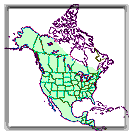
The ubiquitous Coyote is found throughout North America from eastern Alaska to New England and south through Mexico to Panama. It originally ranged primarily in the northwest corner of the US, but it has adapted readily to the changes caused by human occupation and, in the past 200 years, has been steadily extending its range. Sightings now commonly occur in Florida, New England and eastern Canada.
The Coyote is a member of the dog family. In size and shape the Coyote is like a medium-sized Collie dog, but its tail is round and bushy and is carried straight out below the level of its back.
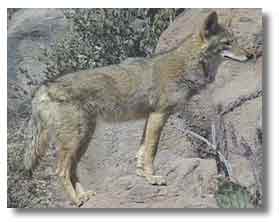
Coyotes found in low deserts and valleys weigh about 20 pounds, less than half of their
mountain kin, who can weigh up to 50 pounds. Desert Coyotes are light gray or tan with a
black tip on the tail.
Coyotes of high elevations have fur that is darker, thicker and longer; the under parts are nearly white, with some specimens having a white tip on the tail. In winter the coats of mountain Coyotes become long and silky, and trappers hunt them for their fur.
Related Species
The Coyote is one of 8 species of the genus Canis. Four of these are
jackals of Europe, Africa & Asia. Other members of the genus include the Gray Wolf (C.
lupus), the Red Wolf (C. rufus) and all the breeds of the domestic dog (C.
familiaris).
Vocalization
The Coyote is one of the few wild animals whose vocalizations are commonly
heard. At night Coyotes both howl (a high quavering cry) and emit a series of short,
high-pitched yips. Howls are used to keep in touch with other coyotes in the area.
Sometimes, when it is first heard, the listener may experience a tingling fear of
primitive danger, but to the seasoned outdoorsman, the howl of the Coyote is truly a song
of the West.
- Howling - communication with others in the
area." Also, an announcement that "I am here and this is my area. Other males
are invited to stay away but females are welcome to follow the sound of my voice. Please
answer and let me know where you are so we don't have any unwanted conflicts.
- Yelping - a celebration or criticism within a small
group of coyotes." Often heard during play among pups or young animals.
- Bark - The scientific name for coyotes means
"Barking dog," Canis latrans. The bark is thought to be a threat display when a
coyote is protecting a den or a kill.
- Huffing - is usually used for calling pups without
making a great deal of noise."
Listen here Quicktime
-->Tail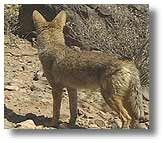
The Coyote's tail is used in threat displays. It becomes bush and is held horizontally
when the Coyote displays aggression.
Ears
The Coyote's hearing is very acute and is used for detecting prey and avoiding danger.
Movement and position of the ears is used to communicate mood and rank.
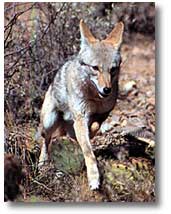 Nose
Nose
The Coyote's sense of smell is highly developed and is used to detect prey and carrion. It
is also used to detect the scent left by other Coyotes as territorial markers.
Feet
The Coyote has 5 digits on the forefeet, including the dewclaw (remnants 5th digit) and 4
digits on the hindfeet. the Coyote is digitigrade meaning it walks with only its
toes touching the ground.
Coyote ComparisonsThe Gray Wolf, (Canis lupus) once shared much of the same range as the Coyote and belongs to the same Genus -- Canis. But the wolf is usually larger and darker in appearance. Coyotes also carry their tails quite differently than wolves. A Coyote's tail is normally held down, although not between the legs. A wolf carries its tail rather horizontally. The nearly successful attempts to exterminate the Gray Wolf (the Coyote's primary predator) has been largely responsible for the Coyote's great expansion across the American continent. |
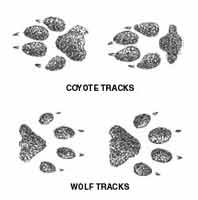 |
Coyote Behavior
One of the most adaptable animals in the world, the
Coyote can change its breeding habits, diet and social dynamics to survive in a wide
variety of habitats.
Alone, in pairs or in packs, Coyotes maintain their territories by marking them with
urine. They also use calls to defend this territory, as well as for strengthening social
bonds and general communication. Coyotes can easily leap an 8 foot fence or wall. They
have been spotted climbing over a 14 foot cyclone fence.
Coyote Vital Statics
|
Curious Coyote Facts Only 5-20% of Coyote pups survive their
first year. |
Although the Coyote usually digs its own den, it will sometimes enlarge an old badger hole or perhaps fix up a natural hole in a rocky ledge to suit its own needs. Dens are usually hidden from view, but they are fairly easy to locate because of the trails that lead away from the den. The Coyote uses the den to birth its young and to sleep. The Coyote does not hibernate.
Coyotes have a good sense of smell, vision and hearing which, coupled with evasiveness, enables them to survive both in the wild and occasionally in the suburban areas of large cities. They are common in most rural areas, but because of their secretive nature, few are seen. Efforts to control or exterminate the Coyote by predator control agents seem to have produced an animal that is extremely alert and wary and well able to maintain itself.
Habitat
Coyotes inhabit all life zones of the Desert Southwest from low valley floors to the crest of the highest mountains, but especially on open plains, grasslands and high mesas. Its natural habitat is open grassland, but it will move to wherever food is available.
Some studies indicate that in the desert, valleys and low foothills, Coyotes occupy a range of no more than 10 or 12 square miles. In mountainous areas they probably have both a summer and winter range, as heavy snows drive them to lower elevations.
Coyote CautionsAs humans expand their living areas and coyotes expand
their range as well, contact is inevitable. Most of the time, coyotes go out of their way
to avoid humans, but they are discovering that humans are a good source for food.
Resourceful and adaptable as coyotes are, they will take advantage of this when they can.
In urban area and in some National Parks the Coyotes are changing their behavior. Coyotes are not your average dog -- they are not to be messed with. They are smart, and they learn quickly. They can be dangerous, and when it comes to urban coyotes, steps should be taken to avoid encouraging them to visit your neighborhood. That means close garbage can lids tightly, do not leave pet food outside and do not leave small pets outside unaccompanied. Coyotes love nothing better than cats and frequently take
small dogs. Inform neighbors of your sighting and encourage them to take steps to NOT
attract the clever little varmints. Remember: Make sure that no pet food is ever left
outdoors. Coyotes usually present little danger to livestock. While they are normally fairly solitary or roam in small groups, at times they may gang up and attack larger animals such as sheep or a pony. During foaling time, do not let foals out without a human around at all times. Coyotes will attack sheep and foals but not adult cattle or horses unless such livestock are sick or extremely weak. |
Food & Hunting
It travels over its range and hunts both day and night, running swiftly and catching its prey easily. It has a varied diet and seems able to exist on whatever the area offers in the way of food. The Coyote eats meat and fish, either fresh or spoiled, and at times it eats fruits and vegetable matter and has even been known to raid melon patches.
Although the Coyote has been observed killing sheep, poultry and other livestock, it does not subsist on domestic animals. Food habit studies reveal that its principle diet is composed of mice, rabbits, ground squirrels, other small rodents, insects, even reptiles, and fruits and berries of wild plants.
The Coyote is an opportunistic predator that uses a variety of hunting techniques to catch small mammals likes rabbits and squirrels, which comprise the bulk of its diet. Although it hunts alone to catch small prey, it may join with others in to hunt larger mammals like young deer or a pony.
The Coyote often tracks its prey using its excellent sense of smell, then stalk it for 20-30 minutes before pouncing. It may also take advantage of its stamina to chase its prey over long distances, and then striking when the quarry is exhausted.
In the dry season they may try to dig for water or find a cattle tank to have a drink. They also derive moisture from their diet. Everything they eat has some moisture in it. There is also the Coyote Melons which grow in the desert. To humans, they taste terrible but they provide moisture and coyotes and javelina are about the only animals that eat them.
Urban coyotes do take advantage of swimming pools, dog water dishes, ponds and water hazards at golf courses and other water bearing human artifacts as a source of moisture. However, the majority of coyotes never see people.
Breeding
At the beginning of the mating season in January, several lone male Coyotes may gather around a female to court her, but she will form a relationship with only one of them. The male and female desert Coyote may travel together before mating in January or February.
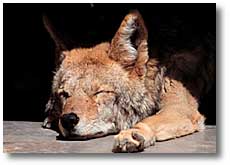 The female bears one litter of 3 to
9 puppies a year, usually in April or May when food is abundant. The gestation period is
from 63 to 65 days.
The female bears one litter of 3 to
9 puppies a year, usually in April or May when food is abundant. The gestation period is
from 63 to 65 days.
The pups are born blind in a natal den, but their eyes
open after about 14 days and they emerge from the den a few days later. They suckle for 5
to 7 weeks, and start eating semi-solid food after 3 weeks. While the male helps support
the family with regurgitated food, the mother does not allow him to come all the way into
the den.
The pups live and play in the den until they are 6 to 10 weeks old, when the mother starts
taking them out hunting in a group. The family gradually disbands, and by fall the pups
are usually hunting alone. Within a year, they go their own way, staking out their own
territory, marked with the scent of their urine.
Conservation
Coyotes have long been one of the most
controversial of all non-game animals. Agricultural interests have urged its control by
whatever means necessary so that actual and potential livestock losses may be eliminated.
Since 1891, when the first programs aimed at control were begun in California, nearly
500,000 Coyotes have been reported destroyed at a cost of an estimated $30 million of the
taxpayers' money.
Environmentalists firmly believe that the Coyotes are necessary to preserve the balance of
nature. Some sportsmen feel the Coyote is responsible for the declines in game species.
Biologists agree that individual animals preying on livestock and poultry should be
destroyed but that the species as a whole is not necessarily harmful, because much of its
diet is made up of destructive rodents. Biologists also agree that Coyote populations have
no lasting effects on other wildlife populations. So the controversy rages on.
Coyotes have recently been classified as non-game animals in California and may be taken
throughout the year under the authority of a hunting license. Meanwhile, despite the
constant hunting and intensive efforts to reduce the Coyote population, on a quiet night
the song of the "Little Wolf" may still be heard throughout the Desert
Southwest.
Have questions? see our FAQ about Coyote
The ubiquitous Coyote is found throughout North America from eastern Alaska to New England and south through Mexico to Panama. It originally ranged primarily in the northwest corner of the US, but it has adapted readily to the changes caused by human occupation and, in the past 200 years, has been steadily extending its range. Sightings now commonly occur in Florida, New England and eastern Canada.
The Coyote is a member of the dog family. In size and shape the Coyote is like a medium-sized Collie dog, but its tail is round and bushy and is carried straight out below the level of its back.

Coyotes found in low deserts and valleys weigh about 20 pounds, less than half of their mountain kin, who can weigh up to 50 pounds. Desert Coyotes are light gray or tan with a black tip on the tail.
Coyotes of high elevations have fur that is darker, thicker and longer; the under parts are nearly white, with some specimens having a white tip on the tail. In winter the coats of mountain Coyotes become long and silky, and trappers hunt them for their fur.
Related Species
The Coyote is one of 8 species of the genus Canis. Four of these are
jackals of Europe, Africa & Asia. Other members of the genus include the Gray Wolf (C.
lupus), the Red Wolf (C. rufus) and all the breeds of the domestic dog (C.
familiaris).
Vocalization
The Coyote is one of the few wild animals whose vocalizations are commonly
heard. At night Coyotes both howl (a high quavering cry) and emit a series of short,
high-pitched yips. Howls are used to keep in touch with other coyotes in the area.
Sometimes, when it is first heard, the listener may experience a tingling fear of
primitive danger, but to the seasoned outdoorsman, the howl of the Coyote is truly a song
of the West.
- Howling - communication with others in the
area." Also, an announcement that "I am here and this is my area. Other males
are invited to stay away but females are welcome to follow the sound of my voice. Please
answer and let me know where you are so we don't have any unwanted conflicts.
- Yelping - a celebration or criticism within a small
group of coyotes." Often heard during play among pups or young animals.
- Bark - The scientific name for coyotes means
"Barking dog," Canis latrans. The bark is thought to be a threat display when a
coyote is protecting a den or a kill.
- Huffing - is usually used for calling pups without
making a great deal of noise."
Listen here Quicktime
-->